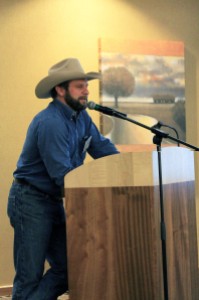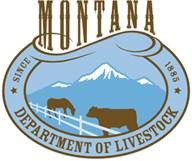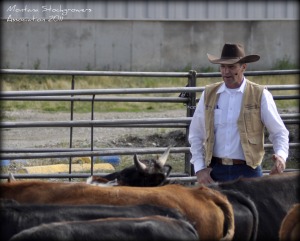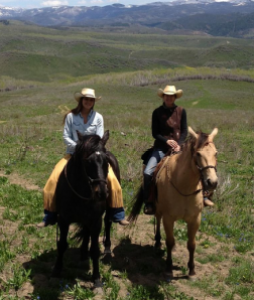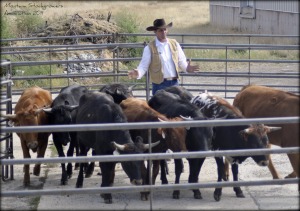 For many Americans purchasing food products at local grocery stores and retailers, there has been a growing movement to learn more about where our food comes from. Many food consumers have been asking to know who produces their food and under what conditions it was raised. Many people are asking for more transparency from food companies in order to learn more about the farming and ranching practices in place. As members of the farming and ranching community, we have a vital role in providing that information.
For many Americans purchasing food products at local grocery stores and retailers, there has been a growing movement to learn more about where our food comes from. Many food consumers have been asking to know who produces their food and under what conditions it was raised. Many people are asking for more transparency from food companies in order to learn more about the farming and ranching practices in place. As members of the farming and ranching community, we have a vital role in providing that information.
One of the more frequently discussed topics among food customers today is about the role of antibiotics use in livestock systems. As livestock producers, we understand there are variety of tools used on farms, ranches and feedlots which include vaccines, good nutrition programs and proper housing to keep animals healthy. Antibiotics are only one tool in a plan of good production practices to raise healthy animals. We also understand the importance of judicious use of these tools to keep them effective for animal health, food safety, costs, and proper management.
Last week, PBS Frontline aired an episode focused on the use of antibiotics and questions surrounding the cause of increasing antibiotic resistance in the human population. Though there are several possible sources for this medical trend, livestock were focused on as a possible cause. As members of the livestock we understand the continual to improve the way we utilize tools such as antibiotics, but we may not always communicate that clearly. It is a cooperation between local producers, veterinarians and federal officials who collaborate to improve our methods with food safety in mind.
With that in mind, we have a few points to address on the issue of antibiotic use in food animals and it’s relation to food safety. To learn more about these topics, be sure to consult your local veterinarian and be sure to share examples of how you ensure judicious and responsible antibiotic use on your livestock operation.
Antibiotic resistance is incredibly complex and it’s rare for a strain of bacteria from our food supply to be resistant to antibiotics.
- Antibiotic resistance occurs when antibiotics attack the majority of bacteria but a few may survive and “mutate” or adapt to the drugs in ways that help them resist treatment by the same drug in the future.
- The vast majority of antibiotic resistant bacteria are non-foodborne, emerging decades ago in hospital settings or communities and are not linked to animals in our food system.
- There are occasional cases of antibiotic resistant foodborne bacteria, such as antibiotic resistant salmonella, but those cases are rare.
The chance a person becomes ill from antibiotic resistant foodborne bacteria and not being able to be treated with alternative antibiotics is slim, with many safeguards built in to keep it from happening, such as responsible antibiotic use, research and surveillance.
- In order for foodborne bacteria to become resistant and impact human health, the bacteria would have to develop a resistant animal strain, survive food processing and handling, proper cooking and find a human with an illness/weakened immune system as the host, survive the human’s body (which will naturally fight the bacteria) and result in a human seeking treatment with the same antibiotic that was used to treat the animal. If antibiotic resistant bacteria were to cause human illness, it means that the standard treatment doesn’t work and that other treatments may have to be considered. So, people becoming ill from antibiotic resistant foodborne bacteria and not being able to be treated in some manner, is extremely rare.
Farmers, ranchers, veterinarians and animal health experts work together to make sure they’re using antibiotics responsibly, in order to reduce the chances of antibiotic resistance forming.
In the animal agriculture industry, we work hard to stop the potential formation of antibiotic resistant bacteria by using antibiotics responsibly:
- Identify the right illness that the animal has by consulting with animal health experts and veterinarians when necessary
- Pinpoint the right treatment and dose needed to treat that specific illness, condition or concern
- Administer the antibiotic for the right amount of time by following the law and clear label instructions (not stopping antibiotics early, which is a threat for antibiotic resistance in humans)
- Conduct the right research to make sure that we continue to protect both animal and human health
Continued research on antibiotic resistance is needed to fully understand antibiotic resistance and address questions about multiple resistance, or co-resistance, which is when bacteria become resistant to several different types or classes of antibiotics and the agriculture community is committed to being part of this important research and dialogue.
- The agricultural community is proactively working to minimize future risk and continuing to conduct research to look at this important topic.
- Everyone – farmers, ranchers, veterinarians, doctors, the government, researchers and companies working in animal or human medicine – needs to work collaboratively to protect animal and human health.
- The agricultural industry is committed to looking at any and all opportunities to mitigate antibiotic resistance in order to make sure we’re continuing to improve the way we use these very important tools.
Antibiotic Use in the Livestock Industry
We can all agree that healthy animals are the basis of a healthy, humane and safe food supply.
- When antibiotics are used, they are used judiciously to keep the potential risk extremely low of developing antibiotic resistant bacteria that is harmful to people.
- The beef community has invested in quality assurance programs, research and education designed to maintain high standards of animal care and health and to help us continuously improve how we use antibiotics.
- Farmers and ranchers have no reason to overuse antibiotics but rather every reason to use them as selectively as possible. For one, it’s the law, but antibiotics also are a costly input for the small business men and women who raise cattle for beef.
- If farmers did not treat sick animals, many would suffer and die. This would be inhumane.
The livestock community, including farmers, ranchers, veterinarians, the federal government and the animal health companies that make antibiotics, proactively are working together to continuously improve the way we responsibly use antibiotics in livestock.
- Changes in FDA Guidance 209 and 213 that will eliminate growth promotion uses of medically important antibiotics and extend veterinary oversight.
- Within about four years, any medically important antibiotics used in animals will only be for therapeutic purposes and under the supervision of a veterinarian.
To learn more about the use of antibiotics in livestock production, visit with a local veterinarian or find a farmer or rancher in the area to ask their perspectives. You can also find more online tools and information at these links:









